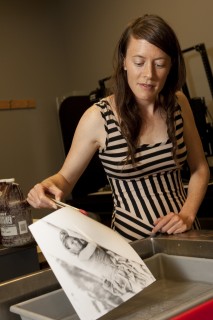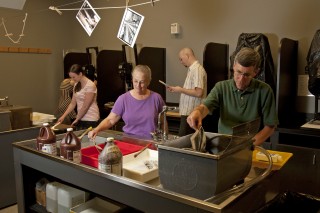This content was published: October 14, 2012. Phone numbers, email addresses, and other information may have changed.
Life in the darkroom: Instructor Mike Riches teaches photography old school
Story by Christina Holmes. Photos by Vern Uyetake.
 Sign up for Mike Riches photography class and it’s a step back in time as you learn how to load 35 mm film, print images using developer and other chemicals and watch as pictures slowly appear on photo paper in a darkroom.
Sign up for Mike Riches photography class and it’s a step back in time as you learn how to load 35 mm film, print images using developer and other chemicals and watch as pictures slowly appear on photo paper in a darkroom.
In a world dominated with digital photography, Photoshop programs and software to make anyone look good, Riches’s darkroom photography classes rely heavily on vintage techniques, offering traditional approaches to making pictures.
PCC’s Southeast Center has one of Portland’s best darkrooms, according to loyal students. And in an era where it’s hard to find a functioning darkroom, many are thrilled to see that PCC’s space is open and thriving.
“I like documenting life with black and white photography,” said Stephanie Kreutter, a longtime student who favors old school photography and whose pictures have been featured in galleries in Portland and New York. “Plus, Mike is a great instructor because he’s experienced, humble and knowledgeable.”
When the Southeast Center was built, Riches, a photographer with five decades of experience, had the chance to help design the darkroom. As the son of a photographer who spent years shooting portraits, weddings, landscape, environmental scenes, head shots for professionals and just about everything in between, he was elated.
Initially Riches sat down with a legal sized yellow pad and sketched out the 20-foot by 30-foot room, a space he knows well. Then he worked closely with the architect and engineer to make his ideas come to fruition.
“There are a group of people who pursue darkroom photography as an art form,” said Riches, who’s been teaching at PCC for 25 years. “This art form takes you back in time.” I don’t think anything could kill off digital but there will always be film. It’s similar to why some people like vinyl records when songs now can be downloaded onto their phones.”
Before the Southeast Center darkroom was set up, students used a nearby high school facility that was perfect for teens, but too small for adults. They had to haul in a lot of equipment each night. They made it work as they waited for the new room to open. Now the only darkroom in the entire PCC district is at Southeast Center.
The darkroom students show up several times a week to print photos, learn shooting techniques and critique each others’ work. It’s a tight-knit group that provides honest feedback.
 Kreutter ended up with well-built but older 35 mm cameras – one of her Nikon cameras looks like a lethal weapon, Riches quips – and other equipment thanks to her dad, a photo hobbyist. Now she loves photos of people who go about their normal daily routines. She’s also fond of shooting interesting architecture and constantly comes up with different angles to get offbeat images.
Kreutter ended up with well-built but older 35 mm cameras – one of her Nikon cameras looks like a lethal weapon, Riches quips – and other equipment thanks to her dad, a photo hobbyist. Now she loves photos of people who go about their normal daily routines. She’s also fond of shooting interesting architecture and constantly comes up with different angles to get offbeat images.
“This is a real craft and it takes years to learn,” said Kreutter, whose main job is teaching Spanish to adults and children, but shoots photos whenever she’s not working. “This is not a hobby where there are quick fixes.”
Exactly, says Riches, who adds that with film you only have 36 shots to get the photos you need before the roll is gone. “You only have a moment to shoot and then that moment is gone and it’s not repeatable,” he said.
A few years ago a group of darkroom students submitted their work to a New York gallery where a number of them had multiple entries. The entire class sent nine crates of photos to the gallery in the Chelsea District and another five students traveled to the city for the opening.
For more Community Education classes, visit: www.pcc.edu/community


I don’t see why anyone would not support the idea of safeguarding history; the keeping of darkroom photography is one. I love to sew clothes at my quiet time when breaking away from class work, but most of times, I feel at my best when I do some sewing the traditional way (by hand) irrespective of my owning the newest computerized machines.
I spent a good 25+ years in the darkroom. no one was more thankful for digital photography than me. I even kept my darkroom for another 8 years after I stopped using it. I’d pop in and smell the chemicals very so often. I finally cleaned it it out and it is no more but chemical photography is an art and I’m glad to see that its being kept alive. I have many fond memories of being in the dark room. If I was contacted I might even be interested in helping out.